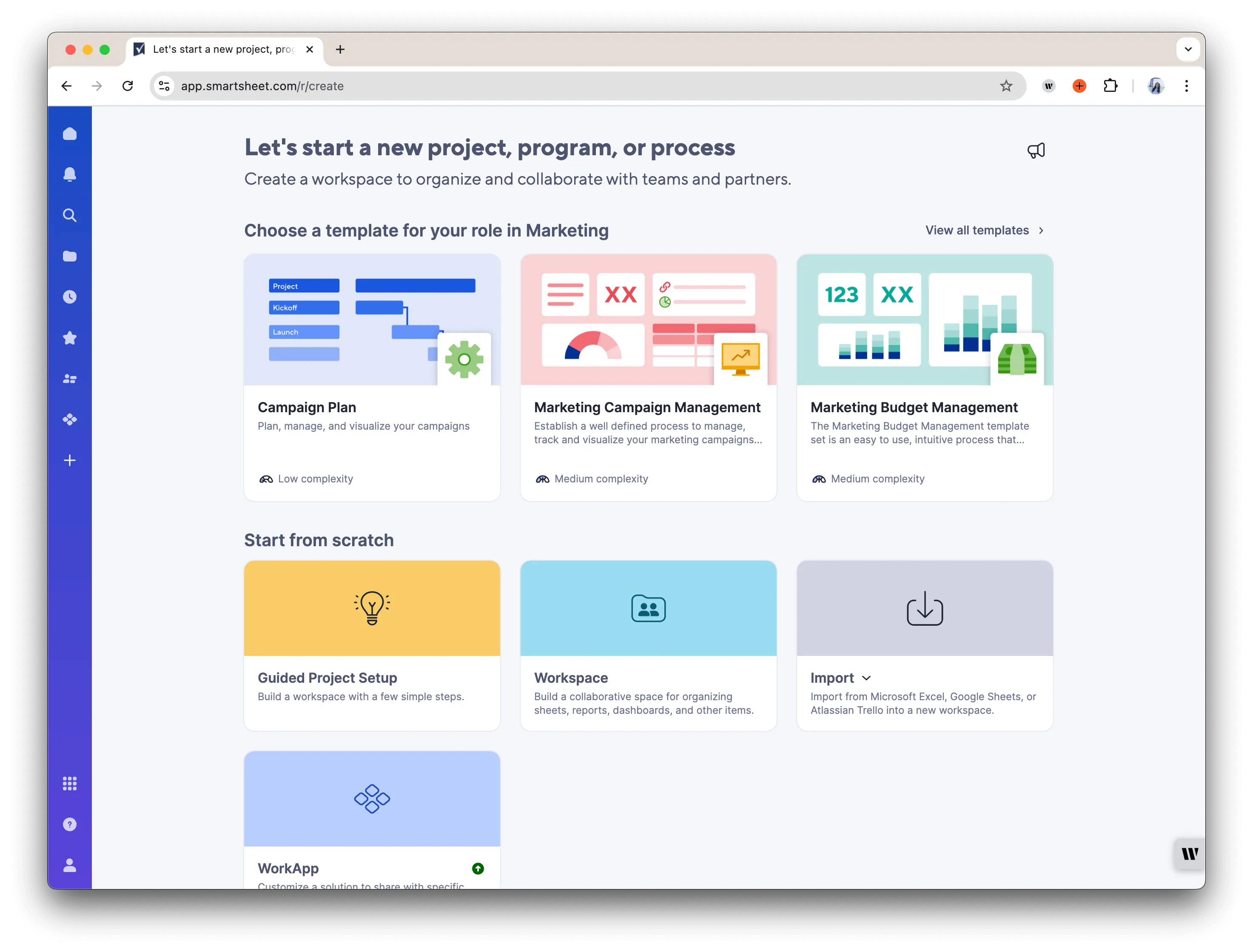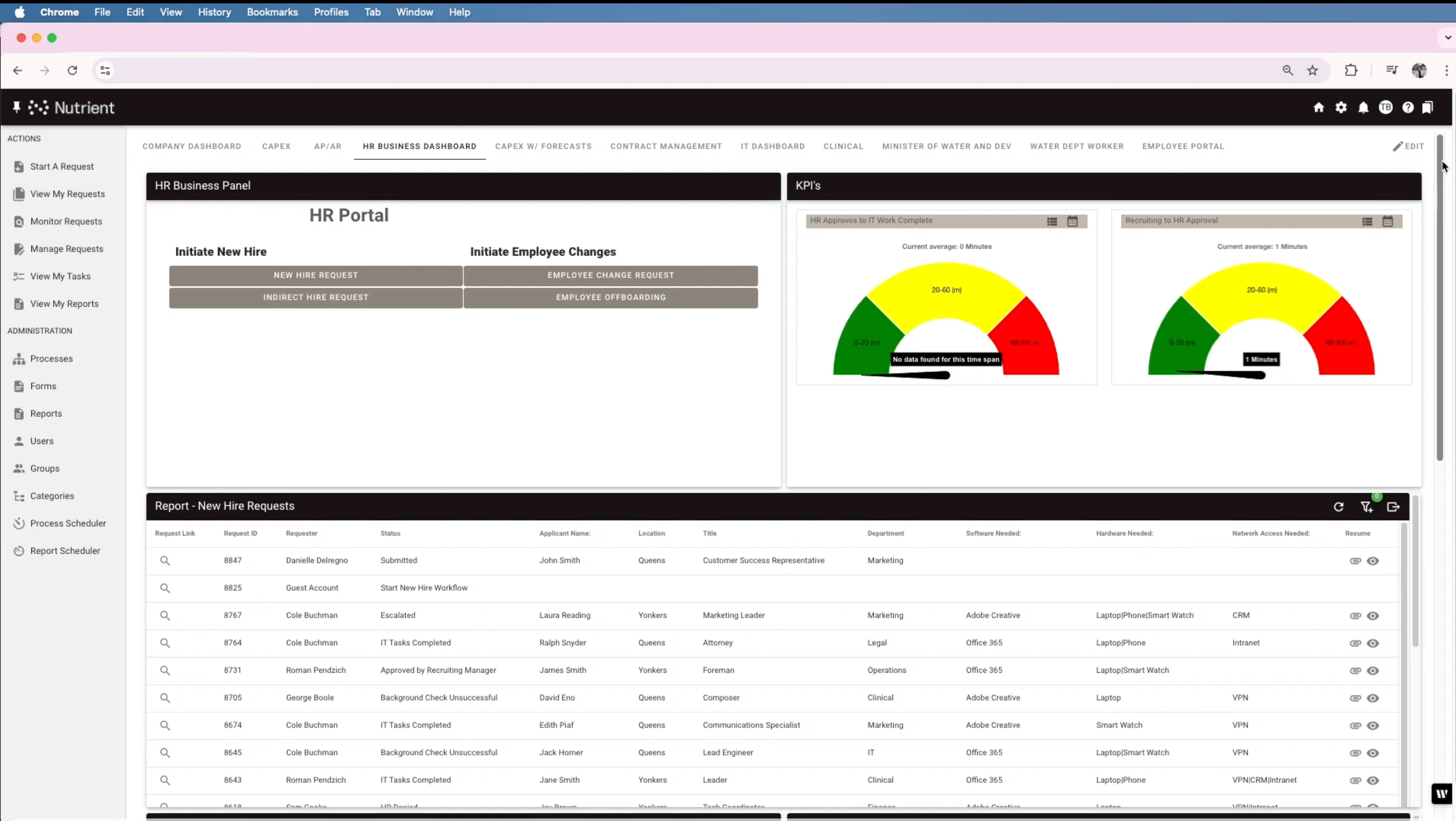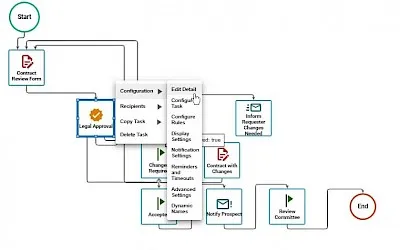Workflow design software: Best tools to automate processes
Table of contents

Wouldn’t it be great if you could take a current business process, lay it out visually, and then just turn it on? No more confusion, emails, Excel spreadsheets, shared documents, or paper forms. You just draw what you want to happen and suddenly everyone knows what they need to do.
Business people are doing this every day with workflow design tools built into workflow automation systems. Tools like Lucidchart(opens in a new tab), Creately(opens in a new tab), and Visio(opens in a new tab) are great for illustrating workflows and sharing them with other team members to ensure a workflow is designed correctly. However, these tools create static illustrations and can’t take the next step, which is workflow automation.
If your ultimate goal is to move manual workflows and processes to a working, automated system, you’re better off finding a true workflow automation tool with an easy-to-use design interface. That way, once the workflow is approved, you can start using it right away in the real world.
Important features of a workflow design tool
Selecting the right workflow design software requires understanding the key features that enable efficient process automation, team collaboration, and decision-making. The next sections include a detailed breakdown of these essential capabilities.
Low-code, drag-and-drop building environment
A low-code, drag-and-drop interface allows users to visually design workflows without needing programming knowledge. This feature is particularly beneficial for business teams that want to automate processes without relying on developers.
🔹 Why it matters:
- Simplifies process creation and modification
- Reduces development time and costs
- Empowers non-technical users to automate tasks
Task assignments and actions
Assigning tasks within workflows ensures responsibilities are clearly defined and actions are efficiently executed.
🔹 Key benefits:
- Enhances accountability by specifying task owners
- Reduces delays with automatic task assignments
- Streamlines approvals, escalations, and dependencies
Collaboration on tasks and requests
Effective workflow tools include built-in collaboration features that allow team members to communicate and manage approvals in real time.
🔹 Why it’s essential:
- Teams can discuss workflows, provide feedback, and share updates
- Reduces miscommunication and delays in process execution
- Supports remote and cross-functional collaboration
Sharing and exporting process flows
Exporting workflows as PDFs, diagrams, or interactive models enables teams to document, analyze, and improve processes over time.
🔹 Key use cases:
- Sharing workflow designs with stakeholders for feedback
- Auditing business processes for compliance and optimization
- Onboarding new team members with clear process documentation
Creation of business rules
Business rules define how workflows operate based on specific conditions, ensuring automated decision-making.
🔹 Capabilities include:
- Conditional logic — Automate processes based on inputs (e.g. If request is urgent, assign to manager)
- Rule-based task routing — Direct approvals or actions to the right individuals
- Data validation — Ensure accuracy in form submissions and data processing
Advanced workflow capabilities
Beyond basic workflow management, the following advanced features enhance process automation and efficiency.
Create child processes
Child processes are sub-workflows that run within a larger process, useful for managing multi-step approvals or dependent tasks.
✅ Example: A purchase request may trigger a child process for budget approval before proceeding to the procurement team.
Create simple or complex business rules
Some workflows require straightforward “if-this-then-that” logic, while others need complex decision trees with multiple conditions.
✅ Example: An HR onboarding process may automatically assign different training programs based on the employee’s department.
Create single, group, or multi-tiered approvals
Approval workflows vary depending on business needs. A single approval may suffice for small expenses, while multi-tiered approvals are required for large purchases.
✅ Example: A group approval could involve multiple managers reviewing a request, and the process moves forward if the majority approve.
Run parallel or sequential flows
Workflows can either:
- Run in sequence (each step depends on the previous one)
- Run in parallel (multiple steps occur simultaneously)
✅ Example: A content approval process may require marketing and legal teams to review something at the same time instead of waiting for one team to finish first.
Set up reminders, customizable notifications, and timeouts
Keeping workflows on track requires automated notifications, deadlines, and reminders.
✅ Example: If an employee doesn’t complete a task within 48 hours, a reminder email is sent. If they don’t respond within 72 hours, the task is automatically escalated.
Test run processes
Before deploying a workflow, businesses can simulate and test the process to identify issues.
✅ Example: A company launching a new client onboarding process can test different scenarios (e.g. missing documents, delays) to ensure smooth execution.
Comprehensive workflow design tools
Workflow design software can be categorized based on its capabilities. Some tools focus solely on visual process modeling, while others provide full workflow automation, and some cater to enterprise-level needs with advanced business process management (BPM) features. Below is a breakdown of the best tools available.
Workflow automation platforms
The following tools enable you to automate workflows.
1. Smartsheet

Smartsheet is a cloud-based platform that enables organizations to plan, capture, manage, and report on work. Its intuitive interface supports collaboration and automation, making it suitable for various industries.
Key features:
- No-code automation
- Real-time collaboration
- Robust reporting capabilities
Pricing: Plans start at $9 per user per month.
Ideal use cases: Project management, marketing campaigns, and operational workflows.
2. FlowForma Process Automation
FlowForma is a no-code process automation tool designed to empower business users to automate workflows without IT intervention.
Key features:
- Forms designer
- Workflow designer
- Document generation
Pricing: Available upon request.
Ideal use cases: Healthcare, construction, and financial services.
3. Creately

Creately is a visual workspace for team collaboration, offering diagramming and design tools to map out workflows and processes.
Key features:
- Real-time collaboration
- Extensive shape libraries
- Integration with popular apps
Pricing: Free plan available; premium plans start at $5 per user per month.
Ideal use cases: Process mapping, organizational charts, and project planning.
4. ClickUp

ClickUp is an all-in-one productivity platform that offers workflow design capabilities alongside task management and collaboration features.
Key features:
- Customizable workflows
- Task assignments
- Time tracking
Pricing: Free plan available; premium plans start at $7 per user per month.
Ideal use cases: Agile project management, marketing workflows, and product development.
5. ProofHub

ProofHub is an all-in-one project management and team collaboration software that centralizes project planning, collaboration, and task management.
Key features:
- Task management with workflows and boards
- Time tracking
- File proofing and versioning
Pricing: Flat rate of $45 per month, billed annually.
Ideal use cases: Creative teams, remote teams, and project management.
6. Nutrient Workflow

Nutrient Workflow offers a comprehensive workflow design tool that allows businesses to visually map out and automate their processes.
Key features:
- Low-code, drag-and-drop interface
- Task assignments and approvals
- Collaboration features
Pricing: Available upon request.
Ideal use cases: Business process automation across various industries.
Comparison of workflow design software
| Feature | Smartsheet(opens in a new tab) | FlowForma(opens in a new tab) | Creately(opens in a new tab) | ClickUp(opens in a new tab) | ProofHub(opens in a new tab) | Nutrient Workflow |
|---|---|---|---|---|---|---|
| Best for | Project management | Business process automation | Visual process mapping | Agile project management | Team collaboration | Business process automation |
| Interface | Spreadsheet style | No-code process builder | Visual workspace | Task-based UI | All-in-one dashboard | Drag and drop |
| Automation | No-code workflows | Business rules engine | Limited | Advanced automation | Task automation | Process automation |
| Collaboration tools | Real-time collaboration | Form-based approvals | Shared workspaces | Team chat and docs | File proofing | Team collaboration |
| Task management | ✔️ | ✔️ | ❌ | ✔️ | ✔️ | ✔️ |
| Workflow customization | ✔️ | ✔️ | ✔️ | ✔️ | ✔️ | ✔️ |
| Integrations | Microsoft, Google, Jira | SharePoint, Office 365 | Slack, Google Drive | Slack, GitHub, Zapier | Google Drive, Dropbox | Custom API |
| Pricing | Starts at $14/user/month | Request pricing | Free, paid from $5/user | Free, paid from $5/user | $89/month (flat rate) | Request pricing |
| Free plan | ❌ | ❌ | ✔️ | ✔️ | ❌ | ❌ |
Basic workflow diagramming tools (for design only)
These tools allow you to visually design workflows but don’t include automation capabilities. They’re ideal for creating flowcharts, process diagrams, and business workflows that can be shared with teams.
| Tool | Description | Pricing |
|---|---|---|
| Visio(opens in a new tab) | Microsoft’s diagramming tool integrated with Office 365. | Starts at $5/user/month |
| Lucidchart(opens in a new tab) | Cloud-based diagramming with templates and real-time collaboration. | Starts at $9/user/month |
| Draw.io(opens in a new tab) | Free, open source diagramming software with a simple interface. | Free |
Enterprise workflow management software (advanced features)
These platforms are designed for large organizations that require advanced business process management (BPM), integrations, compliance tracking, and AI-driven process automation.
| Tool | Description | Pricing |
|---|---|---|
| Appian(opens in a new tab) | AI-powered workflow automation with enterprise-grade security. | Custom pricing |
| IBM Business Automation Workflow(opens in a new tab) | Scalable BPM software with AI-driven insights. | Custom pricing |
| ServiceNow Workflow(opens in a new tab) | Cloud-based workflow automation for IT, HR, and customer support. | Custom pricing |
| Monday.com(opens in a new tab) | Highly customizable workflow and task management tool. | Starts at $9/user/month |
| Asana(opens in a new tab) | Workflow management for team collaboration and project tracking. | Starts at $10.99/user/month |
Considerations for starting a workflow design project
Starting a workflow design project can be a small, focused effort or a broader effort that spans several departments or business units. It’s important to have:
- Strong executive support and ongoing communication from the top that makes the priority of the workflow project clear to everyone.
- Allocation of sufficient resources for the design and management effort.
- A formal workflow improvement plan and toolset so everyone speaks the same language and all process teams produce the same results.
- A clear approval process for implementing workflow changes.
- An initiative run like a true business project with defined responsibilities and milestones.
How to choose the right workflow design software
When selecting a workflow design tool, consider:
✅ Do you need automation or just process mapping? (Design only vs. automation tools)
✅ What level of customization do you require? (Simple workflows vs. complex business rules)
✅ How many users and teams will use it? (Small team vs. enterprise solution)
✅ What integrations do you need? (CRM, email, Slack, Zapier, etc.)
✅ What’s your budget? (Free, subscription-based, or enterprise pricing)
See Nutrient Workflow in action
If you’re interested in seeing how Nutrient Workflow Automation Platform can help you visualize, automate, and streamline business processes, contact Sales, or try it free for 14 days.
FAQ
What is a workflow design tool?
A workflow design tool allows businesses to visually map out and automate their processes, improving efficiency and collaboration.
How do workflow automation tools differ from workflow design tools?
Workflow automation tools go beyond design by automating processes, allowing tasks to be completed without manual intervention after the workflow is set up.
Can workflow design tools be used without technical expertise?
Yes, many workflow design tools are low-code and offer drag-and-drop features, making them accessible, even to non-technical users.
How can a workflow design tool benefit small businesses?
Small businesses can streamline operations, reduce manual tasks, and improve team collaboration by using workflow design tools to automate processes.
Are there any free workflow design tools?
Yes, there are free versions of tools like Draw.io(opens in a new tab) and Lucidchart(opens in a new tab), which offer basic workflow design features.








